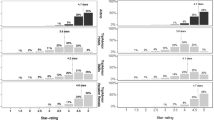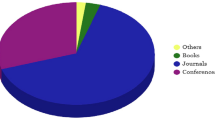Abstract
In this paper we present a trust and reputation model to classify and filter collaboratively contributed geographic information. We hypothesize that users contribute information in a collaborative system akin to Web 2.0 collaborative applications. We build on previous work where trust is proposed as a proxy for information quality and propose a spatial trust model to filter and extract high quality information about urban growth behaviors contributed by users. The motivating scenario involves residents of recently urbanized areas taking into account their interactions with their surroundings. The main contribution of this paper is a formal trust and reputation model that takes into account the spatial context of users and their contributions.

Similar content being viewed by others
References
Agarwal, Ch., Green, G. M., Grove, J. M., Evans, T. P., & Schweik, Ch. M. (2000). A review and assessment of land-use change models: Dynamics of space, time, and human choice. In 4th International Conference on Integrating GIS and Environmental Modeling, Problems, Prospects and Research Needs. Banff, Alberta, Canada, 2–8 September 2000.
Barredo, J., Kasanko, M., McCormick, N., & Lavalle, C. (2003). Modeling dynamic spatial processes: Simulation of urban future scenarios through cellular automata. Landscape and Urban Planning, 64, 145–160.
Berry, B. (2004). A theoretical model for measuring the influence of accessibility in residential choice behaviour. In 44th European Congress of the European Regional Science Association, Porto, Portugal.
Bishr, M. (2007). Weaving space into the web of trust: An asymmetric spatial trust model for social networks. CSSW. Leipzig, Germany: Bonner Köllen Verlag.
Bishr, M., & Kuhn, W. (2007). Geospatial information bottom-up: A matter of trust and semantics. AGILE. Aalborg, Denmark: Springer.
Bishr, Y. A., & Pundt, H., et al. (1999). Probing the concept of information communities-a first step toward semantic interoperability. In M. F. Goodchild (Ed.), Interoperating geographic information systems (pp. 55–70). Springer.
Buskens, V. W. (2002). Social networks and trust. Dordrecht: Springer.
Cecchini, A., & Rizzi, P. (2001). Is urban gaming simulation useful? Simulation Gaming, 32(4), 507.
Cheng J., & Masser, I. (2003). Understanding urban growth system: Theories and methods. In 8th International Conference on Computers in Urban Planning and Urban Management, Sendai City, Japan.
Golbeck, J. A. (2005). Computing and applying trust in web-based social networks. Department of Computing, PhD thesis, University of Maryland.
Goodchild, M. F. (2007). Citizens as sensors: The world of volunteered geography. GeoJournal, 69(4), 211–221.
Huapu, L. (2002). Review of the urban growth over the past twenty years and prospects for the next 2 or 3 decades. Institute of Transportation Engineering, Tsinghua University.
Janes, J. W., & Rosenfeld, L. B. (1996). Networked information retrieval and organization: Issues and questions. Journal of the American Society for Information Science, 47, 711–715.
Kaufer, D., & Carley, K. (1993). Communication at a distance: The effect of print on socio-cultural organization and change. Hillsdale, NJ: Lawrence Erlbaum.
Luo, X., & Sen, J. (2004). Cross-border urban growth: The case of Jiangyin economic development zone in Jingjiang. In 15th Biennial Conference on the Asian Studies Association of Australia, Canberra.
McPherson, M., Smith-Lovin, L., & Cook, J. M. (2001). Birds of a feather: Homophily in social networks. Annual Review of Sociology, 27, 415–444.
McGuinness, D. L., & da Silva, P. P., et al. (2004). IWBase: Provenance metadata infrastructure for explaining and trusting answers from the web. Springer.
Metcalf, S., & Paich, M. (2005). Spatial dynamics of social network. Evolution, 51, 61801.
Ness, G. D., & Low, M. M. (2000). Five cities: Modelling Asian urban population-environment (pp. 43–67). Oxford University Press: Dynamics.
Nohria, N., & Eccles, R. G. (1992). Networks and organizations: structure, form, and action. Boston, MA: Harvard Business School Press.
Oreilly. (2005). http://www.oreillynet.com/pub/a/oreilly/tim/news/2005/09/30/what-is-web-20.html
Otoo, E. A., Whyatt, D. J., & Ite, U. E. (2006). Quantifying urban growth in Accra metropolitan area (Ama), Ghana and Exploring Causal Mechanisms, England Promoting Land Administration and Good Governance 5th FIG Regional Conference Accra, Ghana.
Seligman, A. B. (1997). The problem of trust. Princeton University Press.
Surowiecki, J. (2004). The wisdom of crowds: Why the many are smarter than the few and how collective wisdom shapes business, economies, societies, and nations. New York: Doubleday.
Sztompka, P. (1999). Trust: A sociological theory. Cambridge: Cambridge University Press.
Uslaner, E. M. (2002). The moral foundations of trust. Cambridge: Cambridge University Press.
Verbrugge, L. (1983). A research note on adult friendship contact: A dyadic perspective. Social Forces, 62, 78–83.
Wasserman, S., & Faust, K. (1994). Social network analysis: Methods and applications. Cambridge: Cambridge University Press.
Wellman, B., Salaff, J., Dimitrova, D., Garton, L., Gulia, M., & Haythronwaite, C. (1996). Computer networks as social networks: Collaborative work, telework and virtual community. Annual Review of Sociology, 22, 213–238.
Zaihrayeu, I., da Silva, P. P., & McGuinness, D. L. (2005b). IWTrust: Improving user trust in answers from the web. Springer.
Zaihrayeu, I., & da Silva, P. P., et al. (2005a). IWTrust: Improving user trust in answers from the web, Springer.
Ziegler, C. N., & Lausen, G. (2004). Spreading activation models for trust propagation. The IEEE International Conference on e-Technology, e-Commerce, and e-Service. Taipei, Taiwan.
Zipf, G. (1949). Human behavior and the principle of least effort. Menlo Park, CA: Addison Wesley.
Acknowledgement
The authors would like to thank the anonymous reviewers who have provided constructive feedback. We also would like to thank Sarah Elwood for her efforts in putting this publication in shape. This work is supported by COMPASS project (COastal Marine Perception Application for Scientific Scholarship), financed by e-research:e-Information program of JISC (Joint Information Systems Committee) in the United Kingdom.
Author information
Authors and Affiliations
Corresponding author
Rights and permissions
About this article
Cite this article
Bishr, M., Mantelas, L. A trust and reputation model for filtering and classifying knowledge about urban growth. GeoJournal 72, 229–237 (2008). https://doi.org/10.1007/s10708-008-9182-4
Published:
Issue Date:
DOI: https://doi.org/10.1007/s10708-008-9182-4




